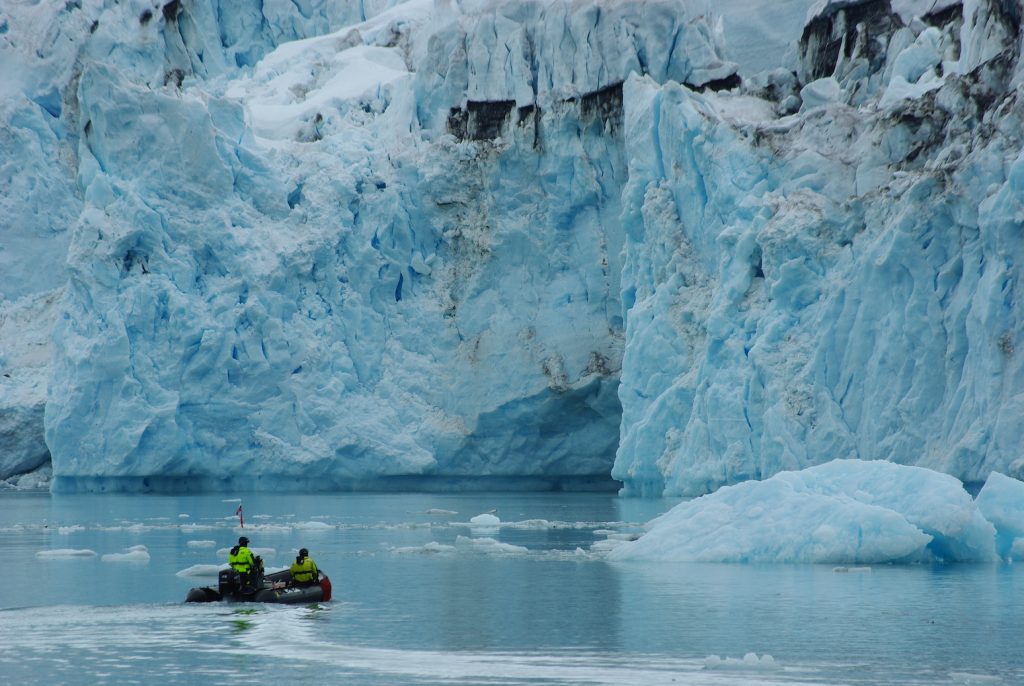A study of seismicity within Perunika Glacier on Livingston Island in Antarctica reveals variable icequake frequency possibly linked to melting ice.
By Makenna Lenover, Temblor Earthquake News extern (@makennalenover)
Citation: Lenover, M., 2021, Icequakes indicate Antarctic glaciers on the move, Temblor, http://doi.org/10.32858/temblor.173

For more than 30 years, research into glacial seismicity — the frequency of non-tectonic seismic events in ice — focused on Greenland, and with good reason. Greenland’s “icequakes,” as scientists call glacier-bound temblors, have been breaking records with increasing frequency, raising alarm about the implications of glacial melting and climate change.
At the opposite pole, much of Antarctic seismicity also results from ice moving and breaking within the thick sheets that cover the continent. As a global phenomenon, icequakes suggest a larger correlation between climate change and ice mass, with icequakes potentially acting as indicators of overall glacial ice conditions — more icequakes, more melting. In an ongoing project, Bulgarian Academy of Sciences and Sofia University seismologist Gergana Georgieva and her colleagues, have been studying seismic activity within the Antarctic Perunika Glacier, located adjacent to the Bulgarian St. Kliment Ohridski Base on Livingston Island.
Tracking Antarctic icequakes
Antarctica is a surprisingly seismically active region, and glacial behavior is crucial to understanding both the underlying topography and climactic influences on the region.

Near the Perunika Glacier sits a single Bulgarian seismic station that has been recording seismic events during the Austral summer since 2015. As of January 2020, the station collects data year-round. Such an investigation has never been conducted in this area, says Georgieva. Through monitoring of these icequakes, Georgieva’s team pinpointed the location of more than 16,000 events — no simple feat with only one station. By accurately locating icequake epicenters — the point at Earth’s surface directly above where a seismic event originates — scientists can better understand these curious quakes’ origins, seasonal variability and change over time.
Epicenter estimates and clusters
Georgieva and her team developed a localization code that calculated and mapped the epicenter of events that lasted between one to three seconds. In this code, a complex algorithm determined the direction of the first incoming seismic wave in three dimensions (north/south, east/west and vertical). Then, by calculating the difference between the first and second incoming seismic waves produced by the event, the code could accurately locate the epicenter. To validate this process, Georgieva calculated the epicenter of several earthquakes detected by both the Bulgarian seismic station and a Spanish research team in the area — the locations matched.
Through this localization process, the team produced reliable data through which they could examine the frequency and distribution of icequakes. “We traced events that happened in the glacier, and then noticed three clusters of epicenters at different parts of the glacier,” says Georgieva. Two of these icequake clusters corresponded to areas of the glacier known for high glacial flow rate, with the third cluster located near Johnson’s Dock, another glacier terminus in the region.
More time, more events
Seismicity has also increased over the duration of the study. “We don’t have enough data just yet to understand how the activity changes across the seasons,” says Georgieva, “so this will be an important next step,” made possible by the year-round station installation. In addition to tracking change in seasonal activity, Georgieva and her team will compare the seismic data with long term meteorological information to explore links between seismicity and weather, which they hope to eventually link to climate. “Each seismic station and season of data collection will allow us to better understand the changes in the region,” said Georgieva, “and give us the opportunity to learn about this glacier and others in the area over different scales of time.”
References
Carmichael, J. D., Joughin, I., Behn, M. D., Das, S., King, M. A., Stevens, L., and Lizarralde, D. (2015), Seismicity on the western Greenland Ice Sheet: Surface fracture in the vicinity of active moulins. J. Geophys. Res. Earth Surf., 120, 1082– 1106. doi: 10.1002/2014JF003398.
Georgieva, G., Dimitrova, L., and Dragomirov, D.: Approach to study the seismicity in the Perunica Glacier, Livingston Island, Antarctica, EGU General Assembly 2021, online, 19– 30 Apr 2021, EGU21-7830, https://doi.org/10.5194/egusphere-egu21-7830, 2021.
Further Reading
Georgieva, G., Gourev, V. (2019). Ice generated events in Perunika Glacier, recorded by LIVV station. European Association of Geoscientists and Engineers Conference Proceedings, 10th Congress of Balkan Geophysical Society, Sep 2019, Volume 2019, p 1-5. https://doi.org/10.3997/2214-4609.201902661
Kufner, S.‐K., Brisbourne, A. M., Smith, A. M., Hudson, T. S., Murray, T., Schlegel, R., et al. (2021). Not all icequakes are created equal: Basal icequakes suggest diverse bed deformation mechanisms at Rutford Ice Stream, West Antarctica. Journal of Geophysical Research: Earth Surface, 126, e2020JF006001. https://doi- org.ezaccess.libraries.psu.edu/10.1029/2020JF006001
- Earthquake science illuminates landslide behavior - June 13, 2025
- Destruction and Transformation: Lessons learned from the 2015 Gorkha, Nepal, earthquake - April 25, 2025
- Knock, knock, knocking on your door – the Julian earthquake in southern California issues reminder to be prepared - April 24, 2025
